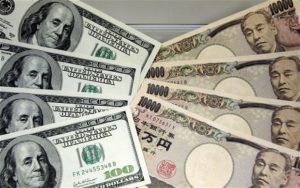 Yesterday’s trade saw USD/JPY within the range of 119.62-120.70. The pair closed at 120.08, shedding 0.21% on a daily basis.
Yesterday’s trade saw USD/JPY within the range of 119.62-120.70. The pair closed at 120.08, shedding 0.21% on a daily basis.
At 7:51 GMT today USD/JPY was losing 0.62% for the day to trade at 119.33. The pair broke out from the range, as it touched a daily low at 119.11 at 4:15 GMT. It has been the lowest level since August 26th, when a daily low of 118.43 was recorded.
Today the cross may be influenced by a number of macroeconomic reports as listed below.
Fundamentals
United States
Non-farm Payrolls, Unemployment rate
Employers in all sectors of economy in the United States, excluding the farming industry, probably added 220 000 new jobs in August, according to the median forecast by experts, after a job gain of 215 000 in July. If so, this would be the fifth consecutive month, when employment gains exceeded 200 000.
Employment in retail trade rose by 36 000 in July. Health care employment increased by 28 000, while employment in financial services rose by 17 000. Manufacturing employment increased by 15 000, while the sector of transportation and warehousing added 14 000 jobs, according to the report by the Bureau of Labor Statistics (BLS).
The non-farm payrolls report presents the total number of US employees in any business, excluding the following four groups: farm employees, general government employees, employees of non-profit organizations, private household employees. The reading, released most often, varies between 10 000 and as much as 250 000 – 300 000 at times when economy is performing well. Despite the volatility and the possibility of large revisions, the non-farm payrolls indicator presents the most timely and comprehensive reflection of the current economic state. Total non-farm payrolls account for 80% of the workers, who produce the entire Gross Domestic Product of the United States. In case of a greater-than-expected gain in jobs, the US dollar would certainly see support.
Average Hourly Earnings probably increased a second month in a row in August, or 0.2%, according to the median forecast, following another 0.2% surge in July.
The rate of unemployment in the country probably dropped to 5.2% in August from 5.3% in July. If so, this would be the lowest rate since April 2008, when unemployment was registered at 5.0%.
In case the unemployment rate met expectations or even fell further, this would have a bullish effect on the greenback, because of the positive implications for consumer spending. The Bureau of Labor Statistics will release the official employment data at 12:30 GMT.
Bond Yield Spread
The yield on Japanese 2-year government bonds went as high as 0.019% on September 3rd, or the highest level since July 7th (0.021%), after which it slid to 0.015% at the close to remain unchanged on a daily basis.
The yield on US 2-year government bonds climbed as high as 0.716% on September 3rd, after which it fell to 0.704% at the close to lose 0.008 percentage point for the day.
The spread between 2-year US and 2-year Japanese bond yields, which reflects the flow of funds in a short term, shrank to 0.689% on September 3rd from 0.697% during the prior day. The September 3rd yield spread has been the lowest one since August 27th, when the difference was 0.688%.
Meanwhile, the yield on Japans 10-year government bonds soared as high as 0.408% on September 3rd, or the highest level since August 11th (0.420%), after which it slid to 0.395% at the close to lose 0.001 percentage point compared to September 2nd.
The yield on US 10-year government bonds climbed as high as 2.197% on September 3rd, after which it slipped to 2.167% at the close to lose 2.1 basis points (0.021 percentage point) on a daily basis.
The spread between 10-year US and 10-year Japanese bond yields narrowed to 1.772% on September 3rd from 1.792% during the prior day. The September 3rd yield difference has been the lowest one since August 25th, when the spread was 1.704%.
Daily and Weekly Pivot Levels
By employing the Camarilla calculation method, the daily pivot levels for USD/JPY are presented as follows:
R1 – 120.18
R2 – 120.28
R3 (range resistance – green on the 30-minute chart) – 120.38
R4 (range breakout – red on the 30-minute chart) – 120.67
S1 – 119.98
S2 – 119.88
S3 (range support – green on the 30-minute chart) – 119.78
S4 (range breakout – red on the 30-minute chart) – 119.49
By using the traditional method of calculation, the weekly pivot levels for USD/JPY are presented as follows:
Central Pivot Point – 120.07
R1 – 123.68
R2 – 125.64
R3 – 129.25
S1 – 118.11
S2 – 114.50
S3 – 112.54





